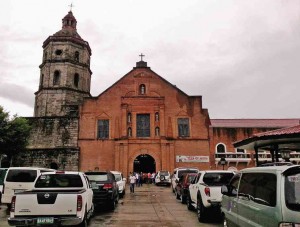Arroyo joins appeal to save old Lubao church

ST. AUGUSTINE Church in Lubao, the oldest and biggest church in Pampanga, is being threatened by a road project of the Department of Public Works and Highways. E.I. REYMOND T. OREJAS/INQUIRER CENTRAL LUZON
LUBAO, Pampanga—Rep. Gloria Macapagal-Arroyo and local officials have joined the Archdiocese of San Fernando in appealing to the Department of Public Works and Highways (DPWH) to adjust the design of a road upgrading project here to preserve the foundations of St. Augustine Church.
The coastal town of Lubao was where Augustinian friars established the first mission in Luzon and built a church that is regarded as the oldest and biggest structure constructed by the religious order in northern and Central Luzon, according to Fr. Teodoro Valencia, parish priest of Lubao, citing research work by Dr. Rodrigo Sicat.
Valencia said Archbishop Paciano Aniceto and Bishop Pablo Virgilio David have expressed concern over the DPWH plan to raise the road around the church by over a meter that may weaken its wood and concrete columns.
The archdiocese, in a summit on June 17, declared the Lubao church among the 23 heritage churches in Pampanga. While declared a national historical landmark, it has not joined St. James Church in Betis, Guagua, and St. Monica Church in Minalin town as national cultural treasures.
Lita Manalo, assistant director of the DPWH Mt. Pinatubo Emergency-Project Management Office, said the agency is raising the road elevation to up to 1.5 meters as a flood-control measure.
The proposed level follows the elevation of Bankerohan Bridge in nearby Sasmuan town as part of the Japanese-funded Pinatubo Urgent Hazard Mitigating Project III, she said.
Volcanic sediments from Mt. Pinatubo’s 1991 eruptions had choked waterways, causing floodwaters to spill inland or delay draining to Manila Bay.
“We have presented the plan to the former parish priest
(Fr. Noli Fernandez) and we are open to a dialogue to tackle their concerns,” Manalo said by phone on Tuesday.
She said Arroyo, through her legislative staff, had sent word urging a revision in the plan.
Valencia said a letter by Aniceto, Mayor Mylyn Cayabyab and the parish pastoral council to DPWH Regional Director Antonio Molano asked the agency to “adopt remedial measures or alterations… by [exempting] the roads near and around [St. Augustine Church], thereby keeping their present elevation.”
In the same letter, they recommended “improving the canal and drainage system to help ensure the efficient drainage of water near and around the structure.”
In her letter to Molano, Arroyo said she appreciated the project but called for “necessary adjustments so that [St. Augustine Church] may be spared from the perils that the project may eventually bring.”
Gov. Lilia Pineda said a balance between saving lives and saving a cultural heritage should be reached in the dialogue that should involve preservation experts.
Francis Musni, a local historian and former Augustinian brother, said the church is “undoubtedly the oldest structure in Lubao, a repository of the historical, cultural and religious memories of the good people of Lubao, and an indelible mark of this town. It has to be protected and conserved.”
If the road is raised by 1.5 meters, Musni estimated that the main front door of the church would be left with less than 2 meters in height.
He said natural sedimentation, lahar flows and man-made filling had claimed or raised the ground by a meter over the centuries.
Sicat said missionaries first built the church using light materials in Barangay Sta. Catalina in 1572 as a chapel of Tondo, Manila.
Because of floods at the original site, they transferred the church to its present site in Barangay San Nicolas I, using stronger materials in 1613. A year later, it housed the first Augustinian printing press in the country.
“A document dated 1829 disclosed that the church of Lubao was constructed by its people with massive masonry stones and bricks,” Sicat said. Tonette Orejas, Inquirer Central Luzon














